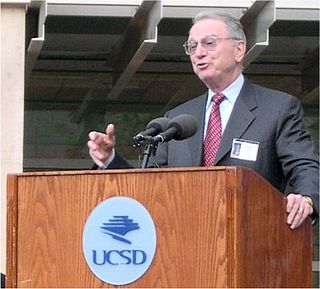Related Research Articles

A Regional Bell Operating Company (RBOC) was a corporate entity created as result of the antitrust lawsuit by the U.S. Department of Justice against the American Telephone and Telegraph Company (AT&T) in 1974 and settled in the Modification of Final Judgment on January 8, 1982.
Pacific Telesis Group (PacTel) was one of the seven Regional Bell Operating Companies, sometimes also referred to as "RBOCs" or "Baby Bells", created in 1983 in preparation of the breakup of AT&T Corporation. Pacific Telesis was the holding company for Pacific Bell, Nevada Bell, Pacific Telesis International, PacTel Mobile Services and PacTel InfoSystems. Pacific Telesis was headquartered in San Francisco and incorporated in Nevada. It was acquired by SBC Communications in 1997, which would eventually become today’s AT&T Inc.
Arun Sarin is an Indian-American telecommunications executive.

Edward Samuel "Ted" Rogers Jr., was a Canadian businessman and philanthropist who served as the president and CEO of Rogers Communications. He was the fifth-richest person in Canada in terms of net worth.

Ivan Seidenberg is the former chairman and CEO of Verizon Communications Inc.

Edward Earl Whitacre Jr. is the former Chairman and CEO of General Motors. He is also a former chairman of the board and chief executive officer of AT&T, previously Southwestern Bell Corporation (SBC). He served as national president of the Boy Scouts of America from 1998 to 2000. On September 1, 2010, Whitacre stepped down as CEO, and retired as chairman of the board by the end of 2010.
Robert William "Bob" Galvin was an American executive. He was the son of the founder of Motorola, Paul Galvin, and served as the CEO of Motorola from 1959 to 1986.

The breakup of the Bell System was mandated on January 8, 1982, by a consent decree providing that AT&T Corporation would, as had been initially proposed by AT&T, relinquish control of the Bell Operating Companies, which had provided local telephone service in the United States. This effectively took the monopoly that was the Bell System and split it into entirely separate companies that would continue to provide telephone service. AT&T would continue to be a provider of long-distance service, while the now-independent Regional Bell Operating Companies (RBOCs), nicknamed the "Baby Bells", would provide local service, and would no longer be directly supplied with equipment from AT&T subsidiary Western Electric.

AirTouch Communications was an American wireless telephone service provider, created as a spin-off of Pacific Telesis on April 1, 1994. Its headquarters were located in the One California building in the Financial District of San Francisco, California. After a series of mergers, the company's vestiges are now part of Verizon.

Irwin Mark Jacobs is an American electrical engineer and businessman. He is a co-founder and former chairman of Qualcomm, and chair of the board of trustees of the Salk Institute. As of 2019, Jacobs has an estimated net worth of $1.2 billion.
Lawrence T. Babbio Jr., generally called Larry, is a former vice chairman and president of Verizon, with responsibility for the Verizon Telecom and Verizon Business units. He was also a member of the board of directors of Verizon Wireless. Since 2007, Babbio has been a senior adviser to Warburg Pincus, a private equity firm. He currently serves as the CEO of Afiniti.
Sir Julian Michael Horn-Smith is a British businessman who is a member of the boards of a number of international corporations and an advisor to others. He was deputy chief executive of Vodafone until July 2006.

CTIA is a trade association representing the wireless communications industry in the United States. The association was established in 1984 and is headquartered in Washington, D.C. It is a 501(c)(6) nonprofit membership organization, and represents wireless carriers and suppliers, and manufacturers and providers of wireless products and services.
Dennis F. Strigl is an American corporate executive. He is the retired president, chief executive officer, and chief operating officer of Verizon Wireless, responsible for operations at Verizon Telecom, Verizon Wireless and Verizon Business. He was appointed on January 1, 2007, and worked for Verizon for about three years until his retirement on December 31, 2009.

Lowell Clayton McAdam is an American businessman. He is the former chairman and CEO of Verizon Communications, a company he joined in 2000.
Wireless Engineering is the branch of engineering which addresses the design, application, and research of wireless communication systems and technologies.
The Program on Information Resources Policy (PIRP) was a research program at Harvard University, sometimes referred to informally as "Harvard's think tank on the information age." See for a complete explanation. It was established on February 1, 1973 by Anthony Oettinger and John LeGates and closed on June 30, 2011 by the same principals. It worked in the realm of communications and information resources. At most points in its history it employed as many as 15 full time staffers, mostly professionals, as well as hosting scores of visiting scholars and sponsored researchers over the years. At any given time it was supported by about 100 different public and private organizations.

Harold Vincent Poor FRS FREng is the Michael Henry Strater University Professor of Electrical Engineering at Princeton University, where he is also the Interim Dean of the School of Engineering and Applied Science. He is a specialist in wireless telecommunications, signal processing and information theory. He has received many honorary degrees and election to national academies. He was also President of IEEE Information Theory Society (1990). He is on the board of directors of the IEEE Foundation.
Andrew Mark Davies is president of Wind Telecomunicazioni Spa since April the 18th 2014. Formerly Vice President and Chief Financial Officer of Verizon Wireless since November the 15th 2010.
References
- 1 2 "Samuel Ginn". www.eng.auburn.edu. Archived from the original on 2018-03-15. Retrieved 2020-03-09.
- ↑ Wireless History Foundation (2015). "Samuel Ginn". Wireless Hall of Fame. Retrieved March 19, 2024.
- ↑ "The Ginn Family Foundation - About Us". ginnfamilyfoundation.org. Retrieved 2020-03-09.